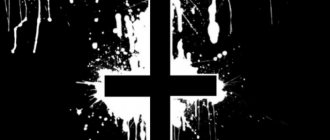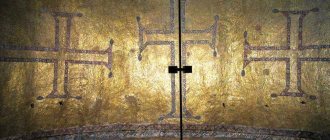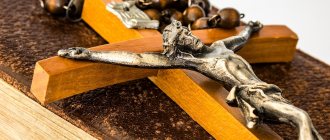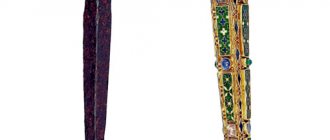How important is it for a baptized person to wear a cross?
Photo: Elitsy.ru
If you ask an Orthodox priest whether a baptized person can do without wearing a cross and why the pectoral cross is so important, he will answer this question as follows:
- a baptized person must wear a cross on his body;
- wearing a cross is an ancient Christian tradition, and modern people should also observe it;
- the cross is put on a person by a priest in the Sacrament of Baptism, as a symbol of belonging to Christ;
- if necessary, the cross can be replaced, but you should not remove it;
- the cross is material evidence of a person’s membership in the Church of Christ;
- if a person takes off his cross, this is evidence of his lack of sufficient faith and church consciousness.
There is no church charter obliging an Orthodox Christian to wear a cross, but doing so is very important. If a person does not wear a cross, this indicates an irresponsible attitude towards Christ and a frivolous attitude towards life.
Is a cross without a crucifix a symbol or just decoration?
The cross is the main symbol of Christianity and an object of Christian art, expressing spiritual meanings through artistic and aesthetic forms. Crosses intended to be worn on the chest, as objects of personal piety and testifying to a person’s Christian service, have been known since the very first centuries of Christianity. But they received especially wide distribution and veneration in Russian Orthodoxy, where the attitude towards the pectoral cross is the most reverent. Of course, the shapes and features of crosses changed over time not only in Rus', but also among different nations, but these changes precisely illustrate the change in theological views and aesthetic tastes in Christian art.
Pectoral crosses constitute an integral group of monuments, but apparently the difference between pectoral and pectoral crosses appeared not so long ago and was not known in ancient times: the cross could be worn freely, both under clothing and on top of it. The Complete Orthodox Theological Encyclopedic Dictionary says that: “a pectoral cross is a cross worn on the chest, either over clothing or under it” (Complete Orthodox Theological Encyclopedic Dictionary. T. 2. St. Petersburg, 1913. P. 1493). Over time, a simple monolithic pectoral cross, given to every Christian at baptism, began to be worn directly on the body under clothing and took the name of a pectoral cross or vest, and worn over clothing - a pectoral cross. The predecessor of the pectoral cross is the so-called encolpion, encolpius from the Greek. έν κολπειώ - behind the bosom, on the chest; literally means a pectoral (breast) cross or a reliquary cross, used in ancient times by Christians, as well as in ancient times in Rus'. It should be noted that the name encolpion is usually applied to products of Byzantine origin and their imitations, and the reliquary cross is applied to the forms of crosses that were born directly in Rus' in the 14th century. But since there are no fundamental differences between crosses worn over clothing and on the body, it is not always possible to say with complete confidence how one or another cross was worn (Yu. A. Fedorov, Image of the Cross. History and symbolism of Orthodox pectoral crosses. St. Petersburg, 2000. P. 5).
Encolpions first had the shape of a four-sided box (less often a circle or oval) consisting of two doors and empty inside, on the outside of which monograms of the name of Jesus Christ were depicted, and later - a cross of various shapes. In this box, particles of relics were kept, and in the era of persecution - lists of sacred Christian books. Later it acquired a cruciform shape and in this form was part of the ceremonial vestments of the imperial rank in Constantinople in Byzantium, and later of the Grand Duke in Rus'. Most Byzantine pectoral crosses preserved in museum collections are encolpions.
In Ancient Rus', folding reliquary crosses, along with other pectoral crosses worn over clothing, were items of princely mane utensils and an accessory of the royal rank. In addition, encolpions were sometimes worn by both bishops and ordinary monastics, as well as pious laypeople, such as pilgrims (usually under their clothes). It is known that according to the court charter of the 10th century of Constantine Porphyrogenitus, the emperor, in compliance with a certain rite, distributed on the feast of St. Prophet Elijah silver crosses to the highest court ranks. Researcher of Byzantine and Old Russian art N.P. Kondakov believes that “even in Ancient Rus', wearing such crosses on chains could not but be associated with a well-known honorary title and served, in a certain sense, as its badge of honor” (Kondakov N.P. Russian Treasures: Study of Antiquities of the Grand Duke's Period, T. 1. St. Petersburg, 1896, p. 181).
Paraman or paramen crosses were also worn over clothing, or rather over armor. Warriors wore them on their chests over their armor, fastening them with braids on their shoulders (ramens), just like a monastic analav (paraman) or chains worn under their clothes. For this purpose, paraman crosses had holes or ears at the top and bottom. Such crosses were used to bless soldiers for feats of arms; they served as spiritual protection and a victorious weapon in the fight against enemies (Yu. A. Fedorov, Image of the Cross. History and symbolism of Orthodox pectoral crosses. P. 4).
The custom of wearing a cross on top of clothes (on the collar) was also found among the people, noting the Christian nature of a person’s service. An example of such wearing is the image of Master Abraham on the Western (Korsun) Gate of Novgorod Sofia (Fig. 1). A researcher of the history of the Russian church of the pre-Mongol period, E. E. Golubinsky, writes that “we wore neck crosses, if not by everyone, then by the princes, and if not always, then sometimes not under the dress, but on top of the dress” (Golubinsky E. E. History of the Russian Churches. In 4 volumes. Reprint of the edition of 1901−1911. M., 1997−2003. T. 2. P. 478). Reliquary crosses, as well as expensive pectoral crosses worn over clothing, were family heirlooms, passed on by inheritance and were often donated to the Church. During the period of the 16th-17th centuries, the wearing of pectoral crosses by laymen, including women, was quite common in Muscovite Rus' (Kapkov K. G. General history of the pectoral cross // Priests - Knights of the Imperial Military Order of the Holy Great Martyr and Victorious George. M ., 2012. pp. 120−132).
In the 17th century, wearing a cross over clothing became more widespread and persisted until the second half of the 19th century. Such a cross had a solemn, festive character. It was complemented by a skillfully made chain and formed a single whole with it. Since the chain was quite wide, it was not threaded into the eye of the cross, as in vests, but was attached to the head with a ring or wire with two loops. But this way of wearing a cross is also confirmed by modern research in the field of ethnography (Yu. A. Fedorov, Image of the Cross. History and symbolism of Orthodox pectoral crosses. P. 4−5).
According to the established modern Russian Orthodox tradition, only a clergyman can wear a pectoral cross over his clothes, while for Orthodox laity it is considered normal to wear a cross under his clothes.
The image of the crucifixion of Christ the Savior, as well as the cross itself, appear quite late in monuments of Christian art. The reason for their late appearance lies in the special idea that existed at that time of the cross and death on the cross as the most shameful form of punishment and death penalty. “It took a long time for the image of the crucified Christ, regardless of its religious significance, to become an open symbol of Christianity and occupy a prominent place in church art; it was necessary for the impression of the recent overwhelming event to be smoothed out so much that the image of the latter no longer aroused the heavy feeling with which it was accompanied in the immediate consciousness of the early Christians” (Golubtsov A.P. From readings on church archeology and liturgics. St. Petersburg, 1995. P. 217). Therefore, only from the 5th century. the four-pointed cross in the Greek or Latin versions of its image becomes commonly used in Christianity (Molodin V.I. European cross-vests // Staurographic collection. Book three: The Cross as a personal shrine. M., 2005. P. 86).
The appearance of the earliest body crosses, or as researchers call them cross-vests, was apparently preceded by sewn-on crosses (6th century), the semantic meaning of which continues the idea of applying a cross to the body: ancient Christians depicted small crosses on the body and mainly on the forehead (see. : Golubtsov A.P. From readings on church archeology and liturgics. P. 240). The use of simple body crosses and encolpions by missionaries is evidenced by their presence in pre-Christian burials. “Often these objects formed part of women’s jewelry along with animal teeth, coins, etc. Perhaps the women who wore these “jewels” really believed in the special magical power of objects of Christian symbolism” (Kuznetsova A.M. Missions of the Latin Church: Experience of the Christian West and Central and South-Eastern Europe at the turn of the second millennium // Christianity in the countries of Eastern, South-Eastern and Central Europe at the threshold of the second millennium. M., 2002. P. 54)
The earliest cross vests are known in Europe and date back to the 6th–8th centuries. These are four-pointed crosses made of metal or stone, which tend to the model of the “Greek cross”, and have equal-sized blades, and their front side and the middle cross are decorated with a circular pattern and sometimes with a circular dot in the center of the middle cross (Fig. 2, 3 and 4) . In the 6th-7th centuries, vest crosses appeared, in which “the figure of the crucified Savior becomes the central character of the cross.” Prominent representatives of such products are bronze crosses from Sebastopolis (Fig. 5) and from Smyrna (Fig. 6), the entire surface of which is occupied by the figure of the crucified Jesus (Fig. 7). Subsequently, significant additions appear through the placement of the faces of the apostles in the round palmettes of the cross crowning the ends (Fig. 8). The most ancient cross-vests among the Eastern Slavs were also similar, the so-called Korsun or korsunchiki with a simple geometric or floral ornament (Fig. 9), which appeared with the adoption of Christianity in the 10th century (Molodin V.I. European cross-vests. P. 86 −91). As a rule, these crosses repeated samples of Byzantine and sometimes Scandinavian origin. They mainly served as a sign of the confession of the Christian faith, introducing a new Christian meaning into the symbolism of earth and life, sun and light familiar to the Slavs (Yu. A. Fedorov. Image of the Cross. History and symbolism of Orthodox pectoral crosses. P. 6).
In parallel with this, another tradition of cross-vests with the image of the crucified Savior arises. They are distinguished by their rather large proportions, as well as the placement of the figure of the crucified Jesus on the entire surface of the front part of the cross. Both iconographic traditions were further developed. So on the cross from Mainz (VII or VIII century), in its title above the head of the Savior, there is a tablet with the inscription: IСХIN? (further unreadable) - Jesus Christ from Nazareth, and above it are two relief circles with symbols of the Sun and Moon (Fig. 10). On another similar cross from the village of Sady (Czech Republic), in the head of the cross, above the head of the Savior, the hand of God is depicted (Fig. 11), and on the Byzantine golden cross of the 7th century. (Fig. 12) Christ and the four evangelists are depicted (Molodin V.I. European Cross-Vests. pp. 94−100).
The iconography of body crosses from the 10th to 13th centuries is quite laconic. Basically this is an image of Christ - blessing or crucified. The cross, as an instrument of execution, was usually not shown, but was indicated above the Savior’s head in the form of a small cross (Fig. 13). Christ is wearing a lentium (loincloth) or collobium (a long Byzantine robe). “Lentius on the loins of Jesus Christ in the period of time under consideration (from the 6th to the 10th centuries) is found only occasionally; in the 11th century it becomes predominant, and from the 12th century - the only attire of the crucified Savior” (Pokrovsky N.V. Gospel in iconographic monuments, mainly Byzantine and Russian. St. Petersburg, 1892. P. 361). There were no additional attributes of the crucifixion.
Since the 5th century, on papyrus amulets, then on pectoral crosses and encolpions, and even on priestly vestments, there is an inscription of two words written in a cross shape: fw¤j and zw" (phos and zoe), meaning light and life. Sometimes the Greek letters A and W were depicted on or next to the cross (Fig. 14), and the beams of the cross were decorated with floral patterns and often took on the ends the ternary shape of a krin - an ancient symbol of life, and now also of the Life-Giving Trinity. Often, flowering was depicted not at the ends of the beams of the cross, but at its base, which, turning into plant shoots, forked. In this case, the cross took on a shape reminiscent of early Christian images of an anchor or a ship, incorporating their symbolism (Fig. 15). Flourishing crosses in such symbolism are widely known in the art of Byzantium and ancient Rus' at all times (Yu. A. Fedorov, Image of the Cross. History and symbolism of Orthodox pectoral crosses. St. Petersburg, 2000, pp. 6−7).
In the X-XI centuries. in Scandinavia and Northern Europe, body crosses appear with a schematically depicted figure of the crucified Jesus (Fig. 16), and the images of some of them become more schematic (Fig. 17) and primitive compared to their predecessor (Fig. 18). But at the same time, in parallel with them in Europe in the 10th-11th centuries. There are still examples of the simplest forms of crosses without any images, as well as with more complicated and pretentious forms and ornamentation (Fig. 19, 20).
It is noteworthy, for example, that on the golden cross of the 12th century (kept in the National Museum of Copenhagen) the St. Andrew's Cross is depicted in a specially highlighted square (Fig. 21). Absolute analogues of this product, made of bronze and silver, were known in Rus' in the 12th-13th centuries and in Scandinavia.
And in the 12th century. the fashion for cross-vests with the Crucifixion is generally passing in Scandinavia, and they could, for example, as before, be decorated with a circular ornament (Fig. 22), or rounded recesses were made in the corners of their middle cross (Fig. 23) or the corners of the middle cross, like and its center were highlighted with relief circles (Fig. 24) or the rounded blades of the cross, like the middle cross, were designed in the form of medallions (Fig. 25) (Molodin V.I. European cross-vests. pp. 116−117).
In the XIII-XIV centuries, the development of the above-mentioned trends in the iconography of the cross continued. As an example, we can point to the crosses of the late 14th century from a treasure near the village of Ai-Vasil (Crimea): on the front side of one of them there is an image of the Mother of God Hodegetria with a baby in her arms, and on the back there is a Crucifixion (Fig. 26). And on the other cross the images are placed in the reverse order (Molodin V.I. European cross-vests. P. 123−124).
More detailed iconography was on the encolpion crosses. They had images of Christ blessing, the Crucifixion with those present, the sun and moon in the form of astrological signs (Fig. 27), the five-part Deisis, the four evangelists or their symbols, the Mother of God, the apostles, Archangels and especially revered saints (Fig. 28); images were placed not only on the front side, but also on the back side. In the 10th-11th centuries, encolpions came to Rus' from Byzantium and the lands of Asia Minor. Their domestic production until the 13th century (in the pre-Mongol period) was concentrated in Kyiv.
Ancient Russian encolpions repeated Byzantine designs, close to the proportions of a Greek cross with a slightly elongated vertical beam. The most common are encolpions with rounded ends and semicircular protrusions on the sides of each end. The entire space of the cross was occupied by icons (Fig. 29). On ancient encolpions (before the 11th century), they were made using the technique of deep engraving on the polished surface of the cross. Since icons played an important role in the perception of Christianity in Rus', crosses with iconographic images became widespread in subsequent centuries, and most crosses from the 14th century have iconographic images on both the front and back sides (Yu. A. Fedorov, Image of the Cross History and symbolism of Orthodox breast crosses, pp. 6−7).
There are breast crosses that do not have the image of the Savior on the front side, for example, encolpions of the 10th century of eastern origin (Syropalestine region). Their front and back sides without the image of Christ are equivalent, and each has an engraved full-length image of the Mother of God (Fig. 30), the Archangel Michael, or the holy warriors George the Victorious, Demetrius of Thessalonica, Theodore Stratilates, or other locally revered saints. Since the 16th century, on the back of the crosses there has been an image of the holy Guardian Angel, reminiscent of the widespread image on ancient crosses of the Archangel Miail (Yu. A. Fedorov. Image of the Cross. History and symbolism of Orthodox pectoral crosses. P. 17).
Since at least the 15th century, cross-vests were apparently made for the rich and as jewelry. This trend is developing in Europe, as evidenced by some jewelry made of gold and precious stones, where the cross was the semantic basis of the work. So on one of two crosses found in the town of Fishpool (England) and dating back to the 15th century. in the round middle cross a semi-precious stone is inserted, and on the second cross the entire area of the cross is occupied by dark-colored stone inserts (Fig. 31). Also, as an example, we can cite a cross-shaped pendant (Fig. 32), which once belonged to Duke Albrecht V in the 16th century (Molodin V.I. European cross-vests. P. 124).
By the end of the 15th, and especially by the 17th century, pectoral crosses of an eight-pointed shape appeared (Fig. 33) or had protrusions on a vertical beam, imitating elements of an eight-pointed cross (Fig. 34). Subsequently, the eight-pointed cross, having the widest distribution in Rus', becomes a symbol of the Russian Orthodox Church, without detracting from the significance of the four-pointed cross and the cross with two crossbars, which are also recognized as images of the Cross of Christ. He also influenced the basic four-pointed shape of the pectoral cross. (Yu. A. Fedorov. Image of the Cross. History and symbolism of Orthodox pectoral crosses. P. 11).
In the 17th century, in conditions of a general spiritual crisis, as a protection against the influence of Western art and folk beliefs, a unique symbolic language of the Russian Orthodox pectoral cross was formed with a distinctive complexity of form and decorativeness, and the replacement of iconography with symbolic images and inscriptions (Fig. 35, 36). But despite the predominance of such crosses in the period of the 17th-18th centuries, they did not supplant crosses with iconographic images, but later influenced their style (Yu. A. Fedorov. Image of the Cross. History and symbolism of Orthodox pectoral crosses. P. 19 ). And the assertion of some Old Believers that “the image of the Crucified Savior on body crosses appeared quite recently (at least after the 17th century)” (https://starove.ru/obychai/krestik/) is unfounded and is not confirmed by researchers. “Both Old Believers and Nikonians used (in the 18th - early 19th centuries) crosses as vests, the main forms, iconography and decor of which developed in the 17th century. even before the schism... Attempts to interpret any crosses as Old Believer, that is, marking belonging to the Old Believer branch of the Orthodox Church are incorrect, except, perhaps, in those cases when this is evidenced by the version of the prayer of the cross on the back..." (Samigulov G. Kh. More once about cast cross-vests of the late 17th-mid 19th centuries (on the issue of Old Believer crosses) // Russian Culture in Archaeological Research. Omsk, 2008. pp. 216−217).
The reverse side of such symbolic crosses usually performed the function of glorifying the atoning Sacrifice of the Savior and the Cross of the Lord, through which redemption was accomplished. For this purpose, symbolic ornamental motifs were used (Fig. 37), as on the front side of the cross, or texts of prayers and praises to the Cross (Fig. 38). The most common inscription is: “We bow to Your Cross, Master, and glorify Your Holy Resurrection.” No less common are the words of Psalm 67: “Let God rise again, and let His enemies be scattered...”, but words of praise to the cross were also common: “The Cross is the guardian of the whole universe...” or the Jesus Prayer, or the words of the Apostle Paul (1 Cor. 1, 18; Gal. 6, 14). Such texts of prayers on crosses, in addition to their content, also performed an aesthetic function, creating unique ornaments from letters (Fig. 39). On the back of the most ancient Byzantine and Russian corporal crosses there are also petitionary prayers with an appeal to the Lord and the Mother of God and a request for help. An example of this is the inscription on ancient crosses “Help the Mother of God” and the modern prayer inscription that appeared at the end of the 19th century: “Save and preserve.” (Yu. A. Fedorov. Image of the Cross. History and symbolism of Orthodox pectoral crosses. P. 21).
Throughout the history of Christianity, the tradition of veneration of the Cross and the church art associated with it developed and enriched, reflecting the development of Christian theology, iconography and aesthetics of a particular era. The question of the form and practice of wearing a pectoral cross in Orthodoxy is a question of tradition, not canon. Throughout its centuries-old history, it is not known that there were any strict regulations or canons regarding its form, iconography and inscriptions. The existing written regulations and instructions regarding the rules for wearing crosses concern only clergy, and the wearing of a breast cross by laymen is an expression of their personal piety and therefore, apparently, remains in the sphere of oral tradition (Breast crosses of ancient Russian times from the archaeological collections of the State Vladimir Suzdal Museum-Reserve-catalogue. Vladimir, 2013. P. 3). “The cross of any form is the true cross” - these words of St. Theodore the Studite (Reverend Theodore the Studite. Creations. M., 2011) very accurately express the attitude of the Church to the existing diversity of forms of the cross. The Church has never interfered with the expression of personal piety of believers if its forms did not contradict the fundamentals of faith, therefore this issue is resolved individually by each person.
Naturally, wearing a cross as a secular piece of jewelry is unacceptable, since in this case the sacred is used as profane, and this is already blasphemy and desecration of the shrine (blasphemy: 1) insult to the religious shrine; 2) Mockery, desecration of something deeply revered, something that is sacred and dear to someone. Modern encyclopedia. 2000). Christians believe that the Cross, including the pectoral cross, is not only a reminder of our faith and hope, but also the protection of a Christian in difficult circumstances of his life and in temptations: “bless this sign of the Cross and resist all snares Do not give help to the devil for Your intercession” (see Rite “Blessing of the cross to be worn on the body”). In addition, from the Orthodox point of view, the wearing of a cross by a Christian is for him a confession of his faith and evidence that his whole life flows under the banner of the Cross and is a service to Christ. The designated functions express “spatially geometric similarities of this cross on any surface, or its plastic copies made of wood, metal and other materials, with the image of the Crucified One (imago crucifixi) or without it (crux exemplata)” (Ilyin V.N. .Basic questions of the symbolism of the Cross of the Lord // Orthodox Thought. No. 1. Paris, 1928. P. 127).
And here the problem is not in the form itself or the method of transmission, or the design of the cross (as shown above, they could be different), but in the very intention of the person with whom he wears this sacred Christian symbol. After all, just as a jewelry cross with stones and without a crucifix can be a shrine for a person and a confession of his faith, so a “canonical” cross with the image of the Crucifixion of Christ can only be perceived as a stylish and fashionable decoration. And the image of the Cross becomes a sacred image only by the will of the person himself, since it is a property of the act of its reception - a person, with his intention, accepts this object into his world, into the world of his prayers as a sacred symbol, when, by the effort of his will, he calls this picture by the same name as prototype: “... those who look at them are encouraged to remember the prototypes themselves and to love them... For the honor given to the image goes back to the prototype, and he who worships the icon worships the hypostasis of the one depicted on it” (Definition of the Holy Great and Ecumenical Council, the second in Nicaea / Acts of the Ecumenical Councils, published in Russian translation at the Kazan Theological Academy (Kazan, 1909. Vol. 7, pp. 284−285). Therefore, an Orthodox Christian distinguishes: where is the cross as a sacred symbol, and where is a geometric figure, where is the image of the Crucifixion of Christ, and where is jewelry. And for the rest (where this intention for identification and distinction does not exist), that is where our missionary work is most likely necessary.
What do you need to know about the pectoral cross and wearing it?
Photo: Pixabay.com
Since all Christians must wear a pectoral cross, they must understand exactly what it should be like and how to wear it correctly. You should definitely know this about the pectoral cross of a baptized person:
- when wearing a pectoral cross, one cannot perceive it as protection, because God protects a person, and the cross only reminds a person whom he serves and what he lives for;
- the cross is a weapon in spiritual warfare;
- If possible, the cross should always be worn, it accompanies us all our lives;
- if you go for an x-ray or to a bathhouse, you can put on a consecrated wooden cross.
If a baptized person takes off his pectoral cross, then he becomes an easy victim for the devil's temptation, which is why priests never recommend removing the cross. Even our ancestors strictly adhered to the rules, not parting with the pectoral cross under any circumstances, and modern Christians must also adhere to such rules.
( 20 ratings, average: 3.90 out of 5)










